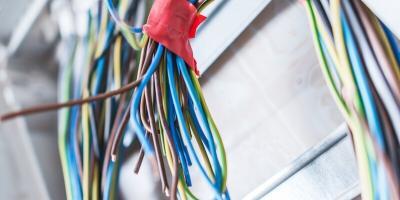Having old electrical wiring at home is dangerous without an inspection!
According to a particular study conducted by the National Fire Prevention Association, poor or faulty electrical wiring is the most common cause of residential fires in Australia. This implies that the older your home is, the greater the chances of it becoming unsafe. If you are unsure of the condition of your wiring system, it would be a great idea to hire a licensed and experienced electrician to inspect your home electrical wiring.
The oldest wiring system in old homes is referred to as knob-and-tube wiring. In this type of wiring, insulating tubes and knobs are used to run the wiring along and through the framing of the house.
Tube-and-knob type of wiring features two individual wires; one white neutral cable and a black hot one. The insulators are used to prevent the wires from touching other. Being a two-cable system, knob-and-tube wiring lacks a ground for safety.
Even though this doesn’t necessarily render the wiring unsafe, it does eliminate a rather critical safety feature found on modern wiring systems. What’s more, it implies that there’s no grounding system to protect sensitive electronics and appliances and this exposes them to potential damage from power surges.
How do I know if the wiring system in my home is old?
If you live in a home that was built between twenty to thirty years ago, then it probably needs rewiring somewhere in your electrical home system. To guarantee the electrical safety in your home, always have an electrical professional inspect your wiring at least once every ten years.
Things to watch out for:
- Damaged, cracked or missing wire insulation which tends to expose the metal part of the wire.
- Wiring surrounded by any type of building insulation.
- Exposed splices wrapped with modern electrical tape. This often indicates that the wires are not soldered. In modern wiring system, exposed slices should be soldered.
- Discoloured switch plates and outlets that are warm to touch.
- A house that was built more than forty years ago.
- Flickering and dimming lights.
- Fuses blow or circuit breakers trip more frequently.
- A burning smell from an electrical device.
- The absence of ground fault circuit interrupter outlets in your kitchen, bathrooms and other areas within the house which may be exposed to either wet or damp conditions.
So what are the dangers of old electrical wiring?
Overloaded electrical circuits
Having an insufficient number of electrical outlets is a typical common problem among old homes. Think of how fast technology has advanced, transforming our lives in a number of ways.
Our homes are now filled with possibly endless electrical devices that consume massive amounts of power. But, has our wiring system been designed to support all of this? The wiring in old homes is often rated for relatively lower amperage than what our modern appliances require.
If the number of electrical outlets in a home is insufficient, then chances are, the available circuits will be overloaded. Most people usually use extension cords as permanent circuits. It should be noted that overloading your circuits is highly dangerous. It can easily result in a fire hazard.
Old or poor electrical insulation
On the issue of insulation, it is not just common with knob and tube type of wiring. Just like any other component, the insulation will eventually deteriorate and become worn out or damaged with age. It could be as a result of a normal ageing process or it could also be damaged by pests such as mice. All in all, a lack of proper insulation only means exposed wires, a phenomenon that can easily cause sparks, shock and fire incidences.
Lack of electrical receptacle grounding
The lack of grounding means all your connected electrical appliances are vulnerable to electrical damage in the event of electrical surges. The grounding of an electrical receptacle also prevents either painful or fatal electrical shocks when power flows via an improper path. Every modern home should have some type of grounding in its electrical system.
Abandoned electrical cables
These are among the common causes of electrical shorts and wiring faults in old houses. You’ll always find loose taped wires, damaged old wires and exposed electrical cables in homes with old wiring systems. Abandoned electrical wires in a building can potentially cause burns, electrical shocks or even death.
Poorly modified wiring
The modern rules for doing electrical work are much more stringent than ever. However, the electrical systems of a significant number of old structures have been tampered with, thanks to decades of DIY dabbling. If you live in an old building, just know that there are high chances that it features faulty wiring or badly executed electrical connections. It is best to get it examined at any cost as this may potentially prevent fire accidents that can be deadly.
These are just some of the dangers posed by the wiring system in old homes. Do not attempt to work on your home electrical wiring unless you are adequately trained and equipped to do so. The best thing you can do is to call your local electrician such as Gordon’s Powers to do the job correctly and perfectly. They are also able to do a complete and thorough inspection of your home electrical system to identify any electrical fault and replace worn out parts that can prevent a major catastrophe from happening.










